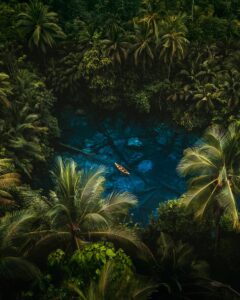
Tom Fähndrich (@tofenpics): Best of the Week 47 at #nomadict
Tom shares the journey behind his winning photography, from a passion for exploration and remote places to field lessons, composition choices, and color grading.
Mihail has been deeply involved in photography since his teenage years. However, it was when he captured his first Milky Way image that he had a profound realization. Four years have passed since that moment, and Mihail has been devotedly working towards transforming his passion into a full-time profession. His dedication has led him to become an accomplished astrophotographer, with a wealth of knowledge and experience to share.
Since my teenage years, photography has been an integral part of my life. It all began when my father gifted me an analog camera with film, which I enjoyed using. However, I later switched to the Russian classic Zenith and eventually bought my first DSLR digital camera. Initially, I shot purely for fun and lacked knowledge of technical parameters such as aperture, speed, and ISO. As a graduate of a school of art, my focus was mainly on composition to convey my feelings through my photography.
It wasn’t until four years ago that I enrolled in a photography class to enhance my understanding of the technical aspects of photography. After completing the course, I struggled to figure out what to photograph, whether it should be weddings, landscapes, or wildlife. But around that time, my wife and I had our daughter, Aya, and caring for our new addition became our priority. The only opportunity I had to photograph was when they were both asleep, and it was typically late at night.
I vividly remember the night I captured my first Milky Way photograph. It was a quiet night in March, and I was wandering along the beach, searching for the perfect spot. The salty scent of the sea, the sound of the gentle waves crashing, and the stars twinkling above me created a magical atmosphere. When I clicked the shutter button, I knew that I had captured something extraordinary. This surprise factor still motivates me to venture out and take photographs, even to this day.
Since my childhood, I have been captivated by the stars. The night sky never ceased to amaze me, and my fascination with the cosmos only grew as I matured. I firmly believe that within each of us, there is a miniature universe, while simultaneously, we are all interconnected to the vast cosmos surrounding us. When we contemplate it, every object – from planets to the tiniest particles – is made up of the same basic building blocks, atoms.
Several months before my first Astro photograph, I spent countless hours scrolling through Instagram, admiring the awe-inspiring pictures of the Milky Way captured by photographers from all over the world. It was my dream to capture similar shots, and when I finally took my first Milky Way core image, it was an epiphany. I had found my passion – this was what I wanted to create and share with the world. And now, four years later, I am working hard to transform my passion into a full-time profession as an astrophotographer.
Throughout my journey as an astrophotographer, I have learned numerous valuable lessons, but some have left a lasting impact.
Firstly, I have come to comprehend that mistakes are a crucial aspect of the learning process. By being inquisitive, dedicated, and passionate, I have attained everything I know about astrophotography.
Secondly, during my initial two years of shooting, I was venturing out at least two to three times every month, experimenting, and committing numerous blunders. However, with time, I have realized that quality supersedes quantity.
Thirdly, motivating myself to abandon my cozy bed, and family, and drive for hours in the dead of the night to capture images used to be a challenge. However, witnessing the results on my camera display screen makes all the effort worthwhile.
Lastly, the beauty of astrophotography is its ability to uncover details and hues that are often invisible to the naked eye. This sense of amazement and surprise is what keeps me feeling invigorated and joyful. For me, it represents the ultimate form of liberation.
Astrophotography has gifted me with numerous extraordinary moments in the great outdoors. It’s a means for me to escape the constant chatter of my mind and wholly immerse myself in the present moment. The sense of inner and outer serenity during these times is unmatched. As I use my camera to capture the splendor of the stars and galaxies, I reflect on my life, express gratitude for the blessings I possess, and put my problems into perspective.
The tranquility of the night sky reminds me that life is a precious gift, and I am incredibly fortunate to have my two incredible children and my wife, who is my confidante.
Astrophotography is not simply a pastime, but a way of life, a form of meditation that grounds me and allows me to perceive the world through a fresh set of eyes.
I use a Sony A7III camera that has been modified for astrophotography, and I have a few lenses that I rely on, including the Sony 14mm F1.8 GM, Sony 24mm F1.4 GM, and Tamron 17-28mm F2.8. When I first started, I believed that expensive and high-speed lenses would make my shots perfect. I tested out various brands and price ranges, but I discovered that it’s not about the equipment; it’s about the person behind the camera.
The value of the image is determined by the concept you have and how you post-process it. Astrophotography is an interpretation of what the camera can capture, and there’s no such thing as a natural-looking night shot. The natural appearance would be a black frame.
Initially, it’s crucial to invest in yourself through tutorials, workshops, online courses, and post-processing tutorials. Once you’ve gained enough experience, you can invest in quality equipment that will work for you, not the other way around. The more I photograph and learn, the more I realize that my ideas and personality are what distinguish me from other astrophotographers. So, my recommendation is to invest in yourself before spending a lot of money on equipment.
In my experience, the key components contributing to a great astro photograph are the idea, atmosphere, technical execution, and post-processing.
Of course, every photographer may have their recipe for success, but for me, the idea behind the photo is paramount. What story do you want to convey? Whether it’s a stunning foreground, a human element, or a celestial event, the image needs to evoke a strong emotional response in the viewer.
The atmosphere of the photo is also crucial in setting the mood and tone of the image. Technical execution showcases the photographer’s skills and experience, while post-processing allows for artistic expression and can elevate the image to new heights.
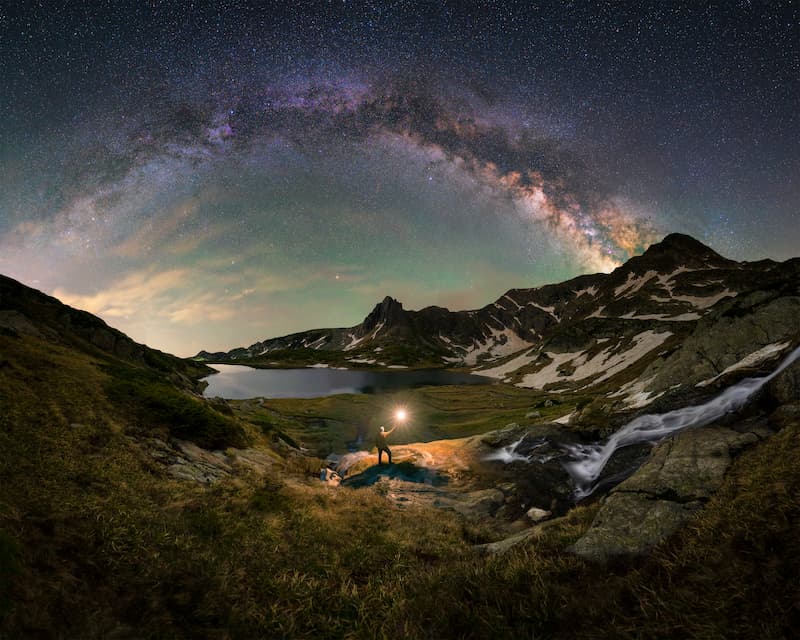
However, it’s important to strike a balance and know when to stop editing to avoid over-processing. In a world where visual content is abundant, a great astrophotograph must capture the viewer’s attention and hold it for more than just a fleeting moment.
Photographing the night sky and celestial objects certainly has its fair share of difficulties, and I have encountered several challenges along the way. The most significant obstacle I face is the lack of light as I primarily shoot during the night, and blending in the blue hour is not my preference. Additionally, the cold weather can be very daunting, especially when shooting in temperatures as low as -15C during the winter. However, the most demanding aspect of shooting in a dark location is finding the right composition to make the most of the scene. It takes time and effort to find the perfect balance between the foreground and the sky, and sometimes, I have to move around multiple times before I find the ideal spot. Despite these challenges, I always push myself to overcome them and produce the best possible images.
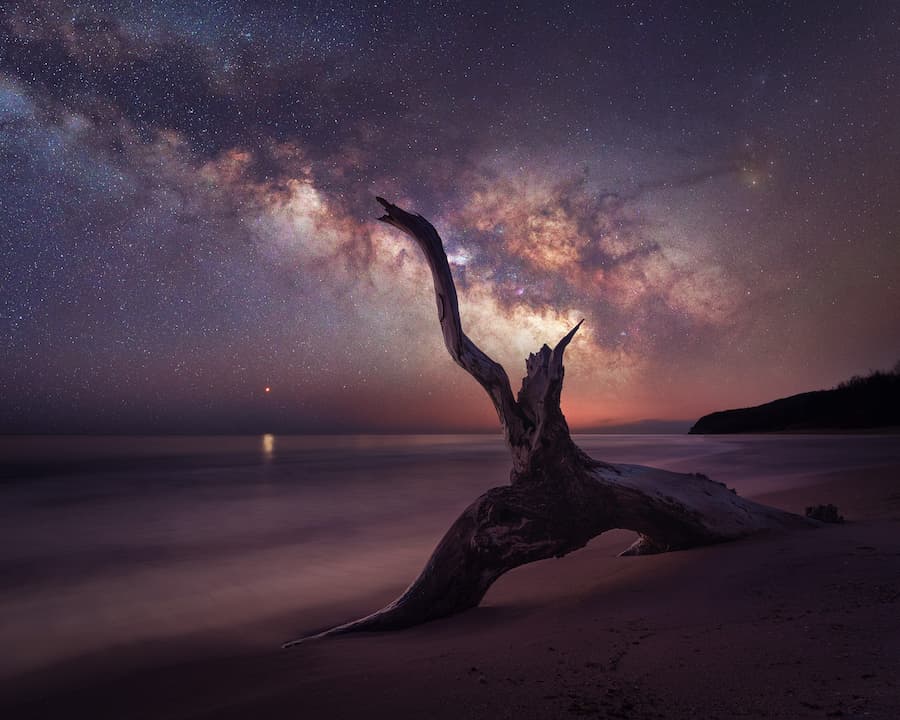
In this regard, there are different ways in which I choose the objects or celestial events to photograph. Sometimes, I plan for specific events such as the Perseid meteor shower or a planet alignment. I carefully scout locations with interesting foregrounds, buildings, or monuments that can add depth and dimension to my images. And, of course, clear skies are always a must, so I keep an eye on the weather forecast.
Other times, I jot down ideas in my notebook and execute them when I have the opportunity. The type of photos I take may depend on the season or what is available to shoot. As a father of two, it can be challenging to find time to shoot with my wife, but when we can make it happen, we enjoy collaborating to create stunning astro photos.
One of my most memorable shoots was in 2020 during the pandemic when there was a planet alignment with a moon rise under the Milky Way arch. I was fortunate to have access to the beach, and the weather was perfect, allowing me to capture a breathtaking image. It was a significant accomplishment when NASA’s Astronomy Picture of the Day featured it. Overall, I find joy in being creative and using my camera to capture the beauty of the universe.
As a photographer, I tend to scrutinize my work once it’s finished, always seeking ways to improve the final product. Nonetheless, there are a few photos that stand the test of time and hold a special place in my heart. One of those photos captures a moment with my daughter Aya when she was just four years old, and we were out together in the field, gazing up at the night sky. Seeing the wonder and joy on Aya’s face, I knew I was creating a memory that we would cherish forever.
As an artist, it’s uncommon for me to still like a photo after a few years, but this one is different. It brings back memories of the magic of that moment and reminds me of the joy of exploring and discovering the world around us. I believe that this photo will serve as a reminder to Aya that there is beauty all around us and that she can always seek out and explore the wonders of the universe. It’s a precious memento of the bond we share and the experiences we’ve had together, and it will always hold a special place in my heart.
People often ask me about capturing the vivid colors and intricate details of the Milky Way. When discussing this topic, I like to explain the limitations of our eyesight in low-light conditions and what my camera is capable of capturing, especially when using a tracked long exposure technique.
In this particular series you see below, I aimed to illustrate the difference between a tracked and stacked shot versus a single exposure, and what our eyes perceive in the field. To do this, I focused on a specific lens: the wide-angle 14mm lens.
When using this lens, we are limited in the amount of light we can capture, and the old rule of 500 no longer applies. Instead, we use the rule of 300 to calculate the appropriate exposure time based on the focal length. With a 14mm lens, we need an exposure time of around 20-25 seconds to maintain pinpoint star details. Depending on the lens speed, f/2.8 or f/1.8, we’ll need to use an ISO of 3200 to 6400, resulting in significant noise in a single exposure.
To avoid noisy images, I use a technique called stacking. This involves taking 10 exposures with the same settings from the same tripod and camera position and processing them with dedicated software. This process eliminates the noise, and the resulting image contains more data, allowing us to extract more colors and details from the sky.
Tracking is another technique used in astrophotography to eliminate the effect of Earth’s rotation. It allows for longer exposures, such as 2, 3, 4 minutes, or more, resulting in low-noise images with perfectly rounded stars and crisp details. Combining tracking and stacking results in stunningly sharp, low-noise images that are perfect for printing, revealing the hidden beauty of the night sky, including colors and details that are invisible to our eyes.
Four years ago, I decided to solely focus on astrophotography, which set me apart from my colleagues in landscape photography. At the time, astrophotography was not a widely practiced genre in my country. As my career progressed, I was allowed to share my knowledge and passion for astrophotography through seminars and workshops, which I found to be incredibly rewarding.
Witnessing the fascination that people had for the night sky and the cosmos was amazing. It’s fulfilling to be able to connect with people on a personal level and to help them develop their skills and interests.
As an artist, I believe that the greatest achievement is not in the number of awards or recognition received, but in the number of people you’ve touched and inspired. It brings me immense joy to know that I have contributed to making others better and more fulfilled in their pursuits.
So my goal is to connect with people on a personal level by sharing my passion through my art and creating meaningful experiences that will stay with them forever. I stay true to my beliefs and let things unfold naturally, as I believe that authenticity is key to creating a lasting impact.

Tom shares the journey behind his winning photography, from a passion for exploration and remote places to field lessons, composition choices, and color grading.
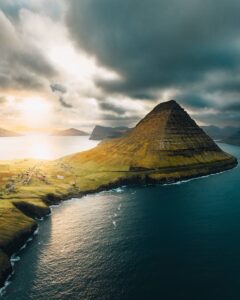
Join us in the Faroe Islands for a unique photo tour, where you’ll elevate your creative skills with expert guidance from Ronald Soethje and Nomadict.
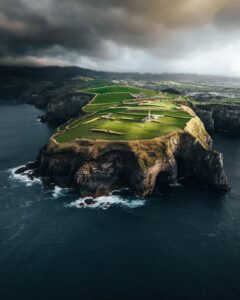
Join us in the Azores for a unique photo tour, where you’ll elevate your creative skills with expert guidance from Ronald Soethje, Bruno Ázera, and Nomadict.
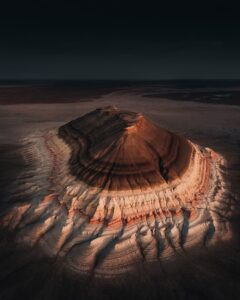
In this article, Forest shares how years of chasing scale, silence, and raw landscapes shaped his approach to photography, from the deserts of Kazakhstan to the volcanic ridges of Iceland. He talks about how he uses light, texture, and vast negative space to create images that feel both intimate and overwhelming.
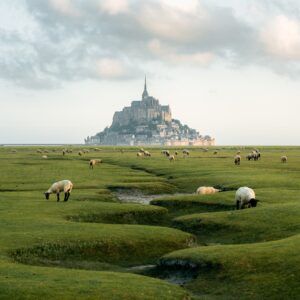
Simon shares the journey behind his photography, from early inspirations to field techniques, editing, and the story of the winning shot that shaped his path.

In this article, Miro shares how his love for cinematic music evolved into a deep passion for photography and how he uses light, color, and atmosphere to turn the streets of Prague into living film scenes.

In this article, Stefanie reveals how her background in physics sparked her passion for astrophotography and how she blends science with creativity to capture the beauty of the night sky. Readers will discover her approach to color, contrast, and editing, as well as her aurora photography workflow.

Spanish photographer Yhabril captures the profound connection between humans and the mountains that shaped him. Growing up in the Pyrenees, his work bridges outdoor sports, landscapes, and celestial scenes — often blending athletes, moonlight, and wilderness into striking visual stories.
